Abstract
Background
The paradoxical association of obesity with mortality, named the “obesity paradox”, has been inconsistent, possibly due to a difference between body mass index (BMI) and central obesity, estimated by waist circumference (WC) as patterns of adiposity.
Subjects/methods
We enrolled 8513 participants from the Kumamoto Intervention Conference Study, a multicenter registry that included consecutive patients undergoing percutaneous coronary intervention (PCI) at 18 centers between 2008 and 2017 in Japan. Patients were divided into quartiles in ascending order of the BMI or WC. The primary endpoints were all-cause mortality and cardiovascular death within a year.
Results
There were 186 deaths (case fatality rate, 22.1/1000 person-years) during the follow-up period. The lowest group (1st quartile) of BMI or WC had the worst prognosis among the quartiles (1st quartile, 4.2%; 2nd quartile, 1.9%; 3rd quartile, 1.5%; 4th quartile, 1.1%; P < 0.001 (χ2) and 1st quartile, 4.1%; 2nd quartile, 2.3%; 3rd quartile, 1.2%; 4th quartile, 1.5%; P < 0.001 (χ2), respectively). Similar results were obtained for cardiovascular death. In a multivariable analysis adjusted by nine conventional factors, the lowest group (1st quartile) of BMI (hazards ratio, 2.748; 95% confidence interval [CI], 1.712–4.411) and WC (hazards ratio, 2.340; 95% CI, 1.525–3.589) were independent prognostic factors for all-cause mortality. By dividing the participants into two groups according to either the BMI or WC based on the National Cholesterol Education Program Adult Treatment Panel III and World Health Organization classification, the highest mortality was observed in the lower group. However, the C-statistic after adding BMI (quartile) to conventional factors was found to be slightly higher than BMI (two categories) and WC (two categories) (0.735 vs. 0.734).
Conclusions
The obesity paradox was observed in patients after PCI, and single-use of BMI (or WC) was sufficient to predict the prognosis of patients after PCI.
This is a preview of subscription content, access via your institution
Access options
Subscribe to this journal
Receive 12 print issues and online access
$259.00 per year
only $21.58 per issue
Buy this article
- Purchase on Springer Link
- Instant access to full article PDF
Prices may be subject to local taxes which are calculated during checkout



Similar content being viewed by others
Data availability
The datasets generated during and/or analyzed during the current study are available from the corresponding author on reasonable request.
References
Abelson P, Kennedy D. The obesity epidemic. Science. 2004;304:1413.
Hori M, Kitamura A, Kiyama M, Imano H, Yamagishi K, Cui R, et al. Fifty-year time trends in blood pressures, body mass index and their relations in a Japanese Community: The Circulatory Risk in Communities Study (CIRCS). J Atheroscler Thromb. 2017;24:518–29.
Hu G, Tuomilehto J, Silventoinen K, Barengo N, Jousilahti P. Joint effects of physical activity, body mass index, waist circumference and waist-to-hip ratio with the risk of cardiovascular disease among middle-aged Finnish men and women. Eur Heart J. 2004;25:2212–9.
Yusuf S, Hawken S, Ounpuu S, Bautista L, Franzosi MG, Commerford P, et al. Obesity and the risk of myocardial infarction in 27,000 participants from 52 countries: a case-control study. Lancet. 2005;366:1640–9.
Uretsky S, Messerli FH, Bangalore S, Champion A, Cooper-Dehoff RM, Zhou Q, et al. Obesity paradox in patients with hypertension and coronary artery disease. Am J Med. 2007;120:863–70.
Klein S, Allison DB, Heymsfield SB, Kelley DE, Leibel RL, Nonas C, et al. Waist circumference and cardiometabolic risk: a consensus statement from Shaping America’s Health: Association for Weight Management and Obesity Prevention; NAASO, The Obesity Society; the American Society for Nutrition; and the American Diabetes Association. Am J Clin Nutr. 2007;85:1197–202.
Pischon T, Boeing H, Hoffmann K, Bergmann M, Schulze MB, Overvad K, et al. General and abdominal adiposity and risk of death in Europe. N Engl J Med. 2008;359:2105–20.
Tabata N, Yamamoto E, Hokimoto S, Yamashita T, Sueta D, Takashio S, et al. Prognostic value of the CHADS(2) score for adverse cardiovascular events in coronary artery disease patients without atrial fibrillation-a multi-center observational cohort study. J Am Heart Assoc. 2017;6:e006355.
Steg PG, Bhatt DL, Wilson PW, D’Agostino R Sr, Ohman EM, Röther J, et al. One-year cardiovascular event rates in outpatients with atherothrombosis. JAMA. 2007;297:1197–206.
Pencina MJ, D’Agostino RB Sr, D’Agostino RB Jr, Vasan RS. Evaluating the added predictive ability of a new marker: from area under the ROC curve to reclassification and beyond. Stat Med. 2008;27:157–72. discussion 207-12
Poirier P. Adiposity and cardiovascular disease: are we using the right definition of obesity? Eur Heart J. 2007;28:2047–8.
Willett WC, Dietz WH, Colditz GA. Guidelines for healthy weight. N Engl J Med. 1999;341:427–34.
Romero-Corral A, Montori VM, Somers VK, Korinek J, Thomas RJ, Allison TG, et al. Association of bodyweight with total mortality and with cardiovascular events in coronary artery disease: a systematic review of cohort studies. Lancet. 2006;368:666–78.
Romero-Corral A, Somers VK, Sierra-Johnson J, Jensen MD, Thomas RJ, Squires RW, et al. Diagnostic performance of body mass index to detect obesity in patients with coronary artery disease. Eur Heart J. 2007;28:2087–93.
Nazare JA, Smith J, Borel AL, Aschner P, Barter P, Van Gaal L, et al. Usefulness of measuring both body mass index and waist circumference for the estimation of visceral adiposity and related cardiometabolic risk profile (from the INSPIRE ME IAA study). Am J Cardiol. 2015;115:307–15.
Oreopoulos A, Padwal R, Kalantar-Zadeh K, Fonarow GC, Norris CM, McAlister FA. Body mass index and mortality in heart failure: a meta-analysis. Am Heart J. 2008;156:13–22.
Clark AL, Fonarow GC, Horwich TB. Waist circumference, body mass index, and survival in systolic heart failure: the obesity paradox revisited. J Card Fail. 2011;17:374–80.
Rodríguez-Reyes H, Lara-Vaca S, Ochoa-Guzmán A, Chiquete E. Obesity paradox and 12 month outcome in patients with atrial fibrillation. Arch Med Res. 2021;52:233–9.
Ono M, Kawashima H, Hara H, O’Leary N, Gao C, Wang R, et al. Impact of body composition indices on ten-year mortality after revascularization of complex coronary artery disease (from the syntax extended survival trial). Am J Cardiol. 2021;151:30–8.
Rauchhaus M, Coats AJ, Anker SD. The endotoxin-lipoprotein hypothesis. Lancet. 2000;356:930–3.
Horwich TB, Fonarow GC. Reverse epidemiology beyond dialysis patients: chronic heart failure, geriatrics, rheumatoid arthritis, COPD, and AIDS. Semin Dial. 2007;20:549–53.
Schenkeveld L, Magro M, Oemrawsingh RM, Lenzen M, de Jaegere P, van Geuns RJ, et al. The influence of optimal medical treatment on the ‘obesity paradox’, body mass index and long-term mortality in patients treated with percutaneous coronary intervention: a prospective cohort study. BMJ Open. 2012;2:e000535.
Schunkert H, Harrell L, Palacios IF. Implications of small reference vessel diameter in patients undergoing percutaneous coronary revascularization. J Am Coll Cardiol. 1999;34:40–8.
Antonopoulos AS, Oikonomou EK, Antoniades C, Tousoulis D. From the BMI paradox to the obesity paradox: the obesity-mortality association in coronary heart disease. Obes Rev. 2016;17:989–1000.
Ross R, Blair S, de Lannoy L, Després JP, Lavie CJ. Changing the endpoints for determining effective obesity management. Prog Cardiovasc Dis. 2015;57:330–6.
Acknowledgements
The present Registry is funded by Daiichi Sankyo Co., Ltd. Japan.
Author information
Authors and Affiliations
Consortia
Contributions
The authors confirm contribution to the paper as follows: study conception and design: YS, NT, KSakamoto, RS, KY, KT; data collection: SH, KSato, TS, KN, HS, TM, STayama, SO, KFujimoto, RT, TH, KKikuta, NS, SN, NY, IK; analysis and interpretation of results: YS, NT, KFujisue, DS, SA, STakashio, YA, SS, EY, KKaikita, KM, KT; draft manuscript preparation: YS, NT, KT. All authors reviewed the results and approved the final version of the manuscript.
Corresponding author
Ethics declarations
Conflict of interest
Koichi Kaikita received research grants and Kenichi Tsujita received honoraria and research grants from Daiichi Sankyo Co., Ltd. The other authors declare no competing interests.
Additional information
Publisher’s note Springer Nature remains neutral with regard to jurisdictional claims in published maps and institutional affiliations.
Rights and permissions
About this article
Cite this article
Shirahama, Y., Tabata, N., Sakamoto, K. et al. Validation of the obesity paradox by body mass index and waist circumference in patients undergoing percutaneous coronary intervention. Int J Obes 46, 1840–1848 (2022). https://doi.org/10.1038/s41366-022-01163-7
Received:
Revised:
Accepted:
Published:
Issue Date:
DOI: https://doi.org/10.1038/s41366-022-01163-7



